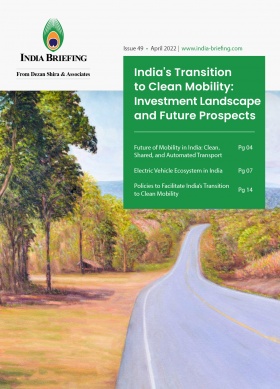A Look at India’s Long-Term Climate Action Strategy
India hopes to achieve net zero emissions by 2070. At the COP27 UN Climate Change Conference being held in Sharm el-Sheikh, India finally submitted its long-term strategy to achieve low greenhouse gas emissions.
However, India has asserted that factors that will override its climate action strategy include energy security and development goals. This is unsurprising. As the global population surpassed the 8 billion milestone this month [UN projection for November 15], India – with a median age of 28 years – is among few countries in the world with a large youth bulge, necessitating high economic growth and employment generation.
To achieve a low carbon and net zero economy, India also needs massive foreign investment by way of funding, infrastructure development, and technology know-how. Already, multiple incentive programs have been launched to push for clean tech and expand renewables capacity.
Moreover, private capital – from large homegrown multinationals to start-ups – are heavily backing technology to drive green goals, renewables, and sustainability.
India is participating at the 27th Conference of Parties (COP27), which is being held at Sharm-el-Sheikh, Egypt from November 6-18, 2022.
On November 14, India presented its Long-Term Low Emission Development Strategy (LT-LEDS) to the United Nations Framework Convention on Climate Change (UNFCCC). Under the 2015 Paris Agreement, all countries had to submit their LT-LEDS document to the UNFCC by 2020 – a way to showcase how they will actually implement respective climate action goals. India is the last of the world’s five biggest economies to submit this strategy document.
As the world’s second-biggest user of coal energy, India made its decarbonization pledge in 2021 alongside other countries to limit global warming to 1.5 degrees Celsius above preindustrial temperatures.
India’s position at COP27
India is prioritizing a gradual transition to cleaner fuels but does not want a single sector, fuel source, or gas to be singled out for climate action. India’s call to “phase down all fossil fuels” has reportedly received support from the European Union.
On decarbonization, India clarified at the COP27 climate summit that its low-carbon development strategy will not come at the cost of food and energy insecurity or slowdown of economic growth and employment.
Moreover, India expects developed countries to take the lead as “the bulk of both finance and technology transfer is available with them.”
What is India doing to achieve net zero emissions by 2070?
To achieve the net zero emissions target by 2070, India is promoting energy generation by renewables through capacity expansion, technology upgrades, push for supply chain indigenization, promotion of electric vehicles (EV), and reducing household consumption.
During a BASIC (Brazil, South Africa, India, and China) ministerial meeting at the summit, India’s Environment Minister Bhupender Yadav said: “Our initiatives include the continued expansion of renewables and the strengthening of the grid, rational utilization of our fossil fuel resources, promoting e-vehicles through major initiatives, steady increase of bio-fuel blending in petrol and diesel, and expansion of our energy efficiency across sectors and drawing in more industrial units. We have a visionary initiative in green hydrogen as the fuel of the future.”
Yadav also added that India recognized the critical role of solar power and has budged for increased production linked incentives for domestic integrated solar manufacturing facilities from INR 45 billion to INR 195 billion in 2022-23. Further, energy storage systems, including grid-scale battery systems, will be given infrastructure status.
India’s approach to climate action
India’s climate action strategy will be focusing on seven areas – electricity, transport, economic and financial aspects, carbon dioxide reduction, industry, urbanization, and forests. Under each thematic area, India is introducing or reworking its policies for implementation.
On its own, the strategy does not represent any major headway in India’s moves to decarbonize. Stakeholders and environmental activists are seeking institutional commitments and are presently unsure what these will look like.
Further, India needs massive foreign capital. The country is the world’s third-largest emitter at a net 2.9 gigatons of carbon-dioxide equivalent (GtCO2e) emitted every year as of 2019, according to analysts at McKinsey. Six sectors – power, steel, automotive, aviation, cement, and agriculture – are responsible for 70 percent of the emissions. Investment opportunities that can address India’s net zero ambitions exist in green hydrogen; carbon capture, usage, and storage (CCUS); natural climate solutions; and material circularity.
Among these, sectors like green hydrogen and nuclear energy are attracting frontline policy support – India wants to be a green hydrogen hub and increase hydrogen electrolyser manufacturing capacity as well as achieve a threefold increase in nuclear capacity by 2032.
India as a green hydrogen hub
India reportedly wants to reach annual green hydrogen production capacity of 25 million tons by 2047. Several Western firms have entered India’s green hydrogen market through joint ventures with domestic companies.
As per the Norwegian research firm Rystad Energy, India will have 8GW of factories in electrolyser manufacturing by 2025. These comprise of seven factory projects involving nine companies and three solo investments. The biggest of these are 2GW factories built by Belgian engineering firm John Cockerill and India’s Greenko in partnership, and the Nevada-based Ohmium. Ohmium has secured US$45 million in private funding to expand its 500MW plant in Bengaluru.
Upcoming 1GW factories expected by 2025 include projects by India’s Reliance conglomerate in partnership with Danish engineering firm Stiesdal, Larsen and Toubro India’s partnership with Norwegian electrolyser manufacturer Hydrogen Pro, and Indian fuel-cell maker H2e Power.
Meanwhile, Adani New Industries Ltd (ANIL) has entered into a strategic alliance with France’s TotalEnergies to create the world’s largest green hydrogen ecosystem. ANIL has committed to a US$50 billion investment over 10 years, and will develop green hydrogen production capacity of 1 million ton per annum before 2030.
At the ‘Invest Karnataka 2022’ meet this month, a third of the total INR 9.81 trillion investment committed was in the green hydrogen sector, with nine green hydrogen manufacturing proposals worth INR 2.86 trillion to be located in the coastal region of Mangalore. Many of these proposals are for setting up electrolyser plants and storing hydrogen produced in the form of ammonia. Hydrogen is the lightest element (with the atomic number 1) and requires high pressure and extremely low temperatures for storage. Liquid ammonia can be stored at -33°C under atmospheric pressure.
Investments in sustainability slowly growing
Investments in sustainability account for 10-15 percent of assets under management (AuM) by private equity (PE) and venture capital (VC) in India as opposed to a third of AuM in the US and 36 percent of AuM globally.
Nevertheless, India is witnessing growth in this space. According to a report by custom research and analytics solutions firm Benori Knowledge, sustainable investments by PE and VC firms could grow to US$125 billion by 2026 at a 46 percent compound annual growth rate (CAGR).
Major contributing factors for the rise in India’s sustainability investments would be consumer expectations for socially responsible brand behavior, government policies, and leap in growth of cleantech and the green economy.
About Us
India Briefing is produced by Dezan Shira & Associates. The firm assists foreign investors throughout Asia from offices across the world, including in Delhi and Mumbai. Readers may write to india@dezshira.com for more support on doing business in in India.
We also maintain offices or have alliance partners assisting foreign investors in Indonesia, Singapore, Vietnam, Philippines, Malaysia, Thailand, Italy, Germany, and the United States, in addition to practices in Bangladesh and Russia.
- Previous Article Investing in Chandigarh, Northwest India: City Profile and Key Industries
- Next Article India Finalizes INR 160 Billion Sovereign Green Bonds Framework to Fund Green Projects









